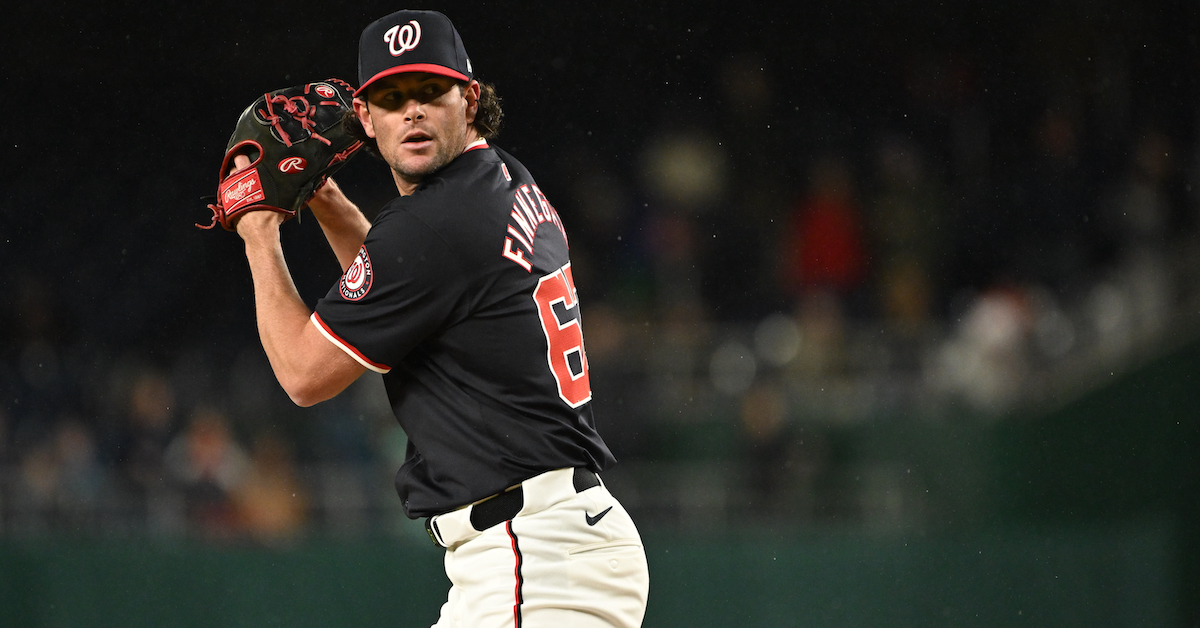
Rafael Suanes-USA TODAY Sports
Kyle Finnegan might be the most underrated closer in baseball. Flying below all but D.C. radar, the 32-year-old right-hander logged 28 saves for the Washington Nationals a year ago, and this season he has 13 saves — no one in the majors has more — to go with a 1.56 ERA. Relying primarily on a 97.3-mph fastball and an 89.8-mph splitter, he’s holding opposing hitters to a .138 average and a .259 slugging percentage in the current campaign. Finnegan’s peripherals (4.41 xERA, 4.06 FIP, 3.45 xFIP, .154 BABIP) suggest that he likely won’t remain this dominant all season, but so far, he has been on of the league’s top relievers.
His ascent to the big leagues took time. Selected in the sixth round of the 2013 draft by the Oakland Athletics out of Texas State University, Finnegan was just shy of his 29th birthday when he debuted in July 2020, seven months after he’d signed with the Nationals as a minor league free agent.
How did he go from a low-profile prospect to a high-level MLB closer?
“It’s kind of been like a slow burn for me, picking up different things and building off past experiences,” Finnegan told me prior to a recent game. “I’ve always had potential. I’ve thrown hard since I was a sophomore in college — I could run it up to 97-98 [mph] — so I really just needed the offspeed to come along. I’ve also been fortunate to be healthy throughout my career. Outside of that, I wish I could give you a rhyme or reason. I think I’ve just gotten a little better every year.”
Finnegan’s split — arguably his most important pitch — dates back to his summer in the Cape Cod League, which followed his sophomore season at Texas State in 2012. During a bullpen session, longtime Cotuit Kettleers coach Mike Roberts showed Finnegan a forkball grip and told the young pitcher about a reliever who utilized it “back in who knows when.” The pitcher was Elroy Face, who famously went 18-1 with 10 saves out of the Pittsburgh Pirates bullpen in 1959. Relying heavily on his signature offering, Face recorded 104 wins and 191 saves and made three All-Star teams over his 16-year career, from 1953-1969.
Unlike Face, Finnegan doesn’t actually throw a forkball. He initially did after learning the grip from Roberts, but it “was much slower, much more tumbling” and subsequently “kind of morphed into a splitter” once he got into pro ball. He’s fine-tuned the pitch over the years, with the primary difference being that he now throws it aggressively. Early on, it was more of a feel pitch for him — “I would try to manipulate it” — and now he “just rips it like a fastball.”
Which doesn’t mean that manipulation went completely out the window.
“I do [manipulate it] to some degree,” said Finnegan. “I mostly try to throw it the same way every time, although some hitters call for a little bit of a different recipe. For most guys you want to throw it on the plate and below — most guys will swing over it — but there are some left-handed hitters who will kind of run out of bat, away. With them you want more horizontal movement as opposed to just straight down.
“When it’s good, it’s like 10 [inches] horizontal and two-to-zero vert. So, it’s pretty down with a little bit of run, but depending on where you place the thumb, you can manipulate the horizontal a little bit. Typically, thumb under you get more down. If you bring the thumb up, you kind of push it horizontal a little bit more.”
Finnegan throws his splitter 26.0% of the time, making it his top secondary pitch. His arsenal also includes 68.8% four-seamers and a slider, to which he added more horizontal break over the offseason. Finnegan used to throw a “tighter, harder, cutter-slider,” but as it was essentially the same velocity as his splitter, some separation was in order. He didn’t get the horizontal break he was looking for with his new slider, but considering that it is the least used of his three pitches – only 5.2% both this year and last – he concluded that whatever additional movement he could get would be enough.
“I set out to throw a sweeper, but I couldn’t quite get enough horizontal to where it would be classified a sweeper,” explained Finnegan. “But really, I think they’re all sliders; some just go more left than others. I kind of settled somewhere in the middle. The sweeper I was trying to throw was about 80 [mph], and the slider I ultimately switched to is around 85. It still moves more left than than my older slider, and I get a little bit of depth on it as well.”
More importantly, what the Michigan-born, Texas-raised righty has been getting is ninth-inning outs on a consistent basis. Since surrendering three runs courtesy of two bombs in a March 31 loss in Cincinnati, Finnegan has made 16 appearances and allowed just one unearned run — hello Zombie runner — over 15 2/3 innings. Moreover, he’s surrendered just five hits over than span.
His attack plan when he takes the mound? Get ahead in the count.
“For anybody out there who wants to to be a better pitcher, just look at the numbers for when you’re ahead in the count,” said Finnegan. “Strike one is king, and strike two is even better. I mean, we talk about it all the time. Do you want to face Ted Williams, or do you want to face a pitcher [hitting]? That’s the difference between being behind and ahead 0-2”
Source
https://blogs.fangraphs.com/kyle-finnegans-most-important-pitch-derives-from-roy-faces-forkball/
 Backyard GrillingWeekend WarriorsAdvice from DadBeard GroomingTV Shows for Guys4x4 Off-Road CarsMens FashionSports NewsAncient Archeology World NewsPrivacy PolicyTerms And Conditions
Backyard GrillingWeekend WarriorsAdvice from DadBeard GroomingTV Shows for Guys4x4 Off-Road CarsMens FashionSports NewsAncient Archeology World NewsPrivacy PolicyTerms And Conditions
